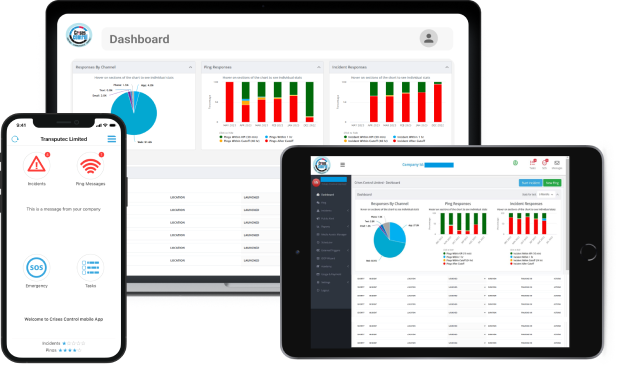Written by Anneri Fourie | Crises Control Executive
Your logistics operation might seem like it’s running smoothly, until something goes wrong. A lorry breaks down, a customs delay halts your shipments, or a warehouse system crashes just as a major delivery is scheduled. Suddenly, the team is scrambling, communication is patchy, and no one seems sure what’s happening next.
These disruptions aren’t rare. In fact, they’re part of the day-to-day reality in logistics. The real question isn’t whether something will go wrong, but whether your team can respond quickly enough to avoid serious impact.
Many logistics businesses are still relying on outdated systems, manual responses, and disconnected tools to handle emergencies. If that sounds familiar, it’s likely time to upgrade to a more advanced Incident Management Software.
Below are five clear signs your logistics team is outgrowing your current setup, along with practical advice on how Crises Control can help you respond faster, communicate better, and recover with confidence.
1. You’re Still Handling Emergencies Manually
Imagine a truck breaks down during a cross-country delivery. You need to notify the driver’s manager, inform the customer, arrange a replacement, and update internal systems. If your response still depends on phone trees, mass emails, or hunting through spreadsheets, you’re wasting valuable time.
Why This Is a Problem
Manual processes leave room for delays and mistakes. In an emergency, even a short delay in notifying your team or customers can lead to missed deadlines, financial penalties, and long-term reputational damage.
How Crises Control Helps
Crises Control allows you to automate emergency communication through multiple channels; SMS, voice, push notifications, and email. Alerts reach everyone instantly, and the system tracks who has received and acknowledged them. No more guesswork. Just action.
2. Your Alerts Aren’t Reaching the Right People Fast Enough
It’s not just about sending alerts. It’s about getting them into the right hands, at the right time, through a channel that works. If you rely on a single method, like email, you’re already on the back foot. Drivers may miss it. Managers may not check their inbox during the night shift. Field staff might not have reliable internet access.
Why This Is a Problem
When alerts go unnoticed, the incident drags on. The damage increases. Field teams are left without direction, and decision-makers operate in the dark.
How Crises Control Helps
The platform delivers alerts through several channels at once and confirms whether they’ve been received and acknowledged. If someone doesn’t respond, the alert automatically escalates to the next contact. You can see, in real time, who’s taking action and where the gaps are.
3. You Can’t See What’s Happening in Real Time
If your team is managing a crisis through a chain of phone calls, email threads, or WhatsApp messages, you’re probably getting different versions of the same story. There’s no single source of truth, and you can’t act with confidence when you don’t know what’s happening minute by minute.
Why This Is a Problem
Without a live overview, managers can’t prioritise resources, track progress, or coordinate effectively across locations. Mistakes are repeated, effort is duplicated, and leadership is left guessing.
How Crises Control Helps
Crises Control provides a real-time incident dashboard, showing live updates as the situation unfolds. Track locations, task completion, and communication trails in one place. No more chasing updates. Just clarity and control.
4. Your Crisis Plans Are Hard to Access or Out of Date
It’s not enough to have a plan if no one can find it. In logistics, where different teams often work across time zones and locations, accessibility and clarity matter. If your emergency plans are stored in a PDF somewhere on a shared drive, they might as well not exist.
Why This Is a Problem
During a disruption, your team needs clear instructions, fast. If they can’t find the plan or if it’s not relevant to the current situation, valuable time is lost.
How Crises Control Helps
The platform lets you upload and embed your crisis plans directly into the system. These digital playbooks are interactive, guiding users step by step through the required actions. You can update them easily and even test them regularly, so your team is always ready.
5. Your Teams and Tools Are Working in Silos
One team uses email, another uses Slack, and someone else updates a spreadsheet that’s already out of date. If your crisis response tools are fragmented, coordination is almost impossible. In logistics, where timing and coordination are everything, this can lead to chaos.
Why This Is a Problem
When your communication, task management, and reporting tools aren’t integrated, you waste time switching between systems and risk missing something crucial.
How Crises Control Helps
Crises Control pulls everything together into one platform; alerts, task tracking, audit logs, and dashboards, so your teams are aligned, your updates are consistent, and your crisis response is smoother from start to finish.
Managing Logistics Crises with Advanced Incident Management Software
Upgrading your approach to crisis response is about more than just modernising your tools. It’s about building resilience, protecting your operations, and making sure your team can respond confidently when things go wrong.
Crises Control is designed to meet the unique demands of the logistics sector, helping you reduce disruption, avoid downtime, and strengthen your ability to recover quickly.
Key Benefits for Logistics Operations
- Multi-channel alerting ensures every team member receives messages wherever they are
- Real-time dashboards provide clear oversight of every incident as it unfolds
- Role-based access ensures sensitive information is only shared with the right people
- Custom response workflows tailored for logistics scenarios like customs delays or driver illness
- Comprehensive audit logs support compliance, review, and continuous improvement
What Logistics Teams Are Saying
Organisations that have implemented Crises Control report:
- Incident response times cut by half
- Triple the rate of acknowledgement for critical alerts
- More confident decision-making during emergencies
- Less disruption for customers and partners
- Clearer post-incident analysis with complete communication records
Is It Time to Rethink Your Incident Management Strategy?
If your team is still using spreadsheets to manage crises or relying on emails and phone calls to spread urgent updates, you’re taking a huge risk. The cost of inaction during a disruption; delayed deliveries, lost customers, compliance failures, can be far greater than the investment in a proper system.
An upgrade to Incident Management Software isn’t just a technical fix. It’s a strategic move towards faster responses, better coordination, and a more resilient logistics operation.
Ready to Take Control?
Don’t wait until your next disruption exposes the cracks in your crisis response. See how Crises Control can help you modernise, streamline, and strengthen your logistics operation with the right tools and support.
Contact us today to book your free demo and experience Crises Control in action.
Request a FREE Demo

